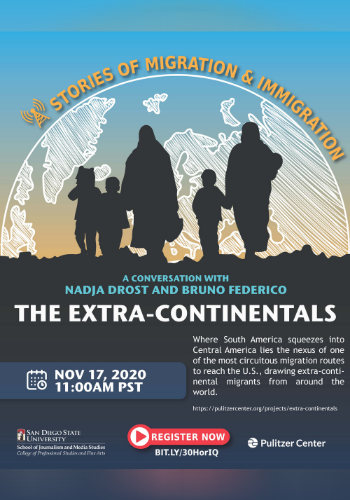JMS Partners with Pulitzer Center to Launch Webinar Series

The mission of the Pulitzer Center is to raise awareness of underreported global issues through direct support for quality journalism across all media platforms. Pulitzer Center grantees typically feature international news stories that are published by news outlets around the world. Co-sponsoring this series with the Pulitzer Center through grant funding has allowed some of their expert journalists to participate in these important conversations.
“I think it’s really fantastic that we’re partnering with this well-established organization to create these webinars because it represents, as a school, who we want to be working with and what we want to be known for,” says Temple Northup, Director of JMS. “Using one theme, in this case migration and immigration, and getting to hear different stories about the process is a great opportunity for our students to learn about these innovative projects as they become future storytellers.”
The first webinar was held on Oct. 6. It featured journalists Lydia Chavez and Sindya Bhanoo who presented their project, “How Do We Survive,” which covered stories of undocumented Americans and Latinx immigrants living below the poverty line as they tried to navigate the impacts of the COVID-19 pandemic. Chavez and Bhanoo specifically focused on individuals living in the Mission District of San Francisco, an area that has been predominantly defined by the wave of immigration in the late 1970s and 1980s from the Central American Wars.
“This neighborhood is very important in terms of resources because of the immigrant population…it is a population that has no safety net,” said Chavez. “All of a sudden, stores are closing, people’s source of income vanishes and people have no savings, so we knew it would be big and we knew it would be a crazy story.”
For this project, Chavez and Bhanoo followed different individuals over time, often experimenting with innovative forms of storytelling to connect the audience emotionally to those they were documenting. For instance, some stories were told using graphic short stories rather than traditional images or video, as Chavez and Bhanoo felt the illustrations could both protect the identity of their subjects while emphasizing their emotional power to the reader.
The second webinar for this series will be held via Zoom on Tuesday, Nov. 17, at 11 a.m. PST. Journalists Nadja Drost and Bruno Federico will discuss their project, “The Extra-Continentals,” which documents the exceptional journey of extra-continental migrants from places as far and disparate as Cameroon, Iran, and Bangladesh. Their journey to reach the United States via South and Central America brings them through one of the most hostile and isolated tracts of land on the globe: a thick jungle known as the Darien Gap that links Colombia to Panama.
More webinars for this series will be held during the spring, with the dates and topics to be announced in January.
To register for the second webinar, visit https://bit.ly/30HorIQ.
The content within this article has been edited by Lizbeth Persons.
